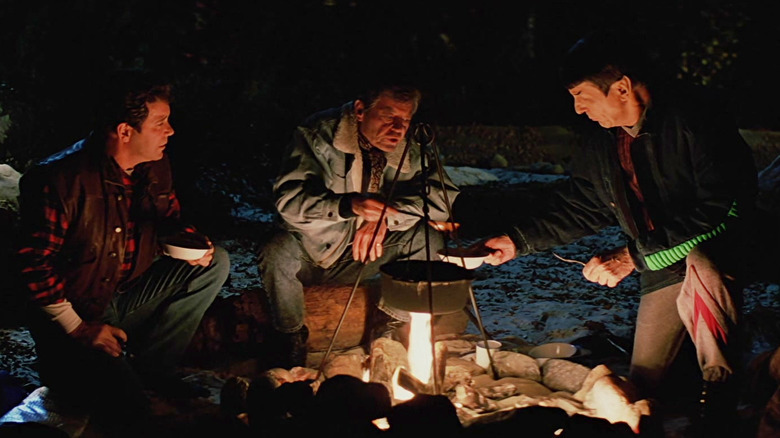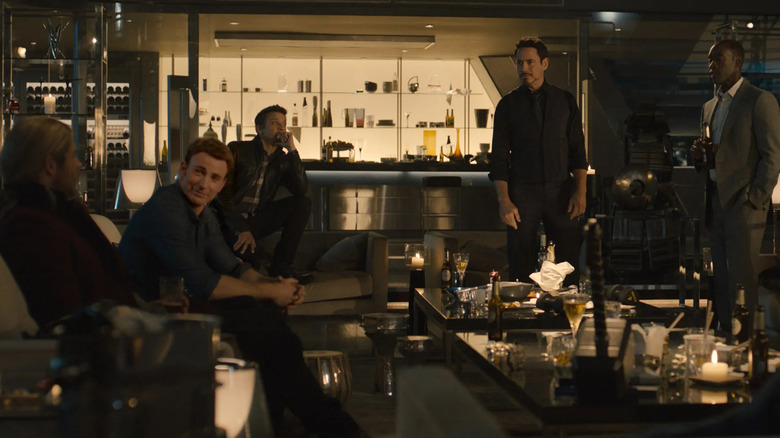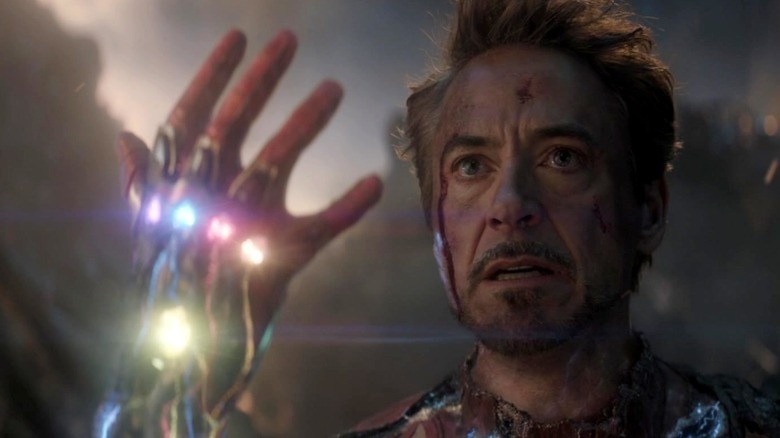The 'Brain-Melting' Star Trek Hot Take That Shaped The Entire MCU
At the beginning of William Shatner's 1989 film "Star Trek V: The Final Frontier," the crew of the U.S.S. Enterprise-A is on shore leave, taking a much-needed breather while their ship undergoes extensive repairs and improvements. Scotty (James Doohan) and Uhura (Nichelle Nichols) are overseeing the repairs back on the ship. Chekhov (Walter Koenig) and Sulu (George Takei) are hiking together in Yosemite while Dr. McCoy (DeForest Kelley), Captain Kirk (Shatner), and Spock (Leonard Nimoy) set up their own camp nearby. This must not be a very long shore leave, otherwise I assume these people would all be at home visiting their families and not hanging out with their co-workers.
At night, McCoy, Kirk, and Spock gather around a campfire, cook beans, and enjoy marshmallows. Everything is comfortably low-tech (with the exception, perhaps, of Spock's specialized marshmallow extruder). Kirk and McCoy attempt to introduce Spock to the Earth tradition of singing songs around the campfire, teaching him the lyrics to "Row, Row, Row Your Boat." Spock is baffled. Life, he says, is not a dream. It's then that a shuttlecraft arrives next to them to transport them back to the Enterprise.
The campfire scene isn't a hugely popular moment in the annals of "Star Trek," and indeed, "Star Trek V" is often reviled as the worst of the Trek movies. Despite this, the campfire scene was — according to the book "MCU: The Reign of Marvel Studios" by Joanna Robinson, Dave Gonzalez, and Gavin Edwards — one of the most inspirational scenes for Marvel head honcho Kevin Feige. Screenwriter C. Robert Cargill, so-writer of "Doctor Strange" recalls Feige confessing his love for "Star Trek V" in a private conversation.
Superheroes who hang out
It's worth repeating that "Star Trek V: The Final Frontier" is the least beloved of the 13 extant "Star Trek" movies. The budget went mostly to the cast, and very little time and money was spent on even the most basic special effects, leaving the film looking cheap and slapped-together. The script began with an interesting concept — what if the Enterprise met the physical manifestation of God? — but it was so hastily written and poorly thought out that the concepts don't land with any notable impact. Despite this, Cargill recalls:
"Kevin made an assertion to me that melted my brain because I'd never heard it [...] He made the argument that 'Star Trek V' is better than 'Star Trek: The Motion Picture.'"
Look at Feige being an edgelord with his hot takes.
And why did Feige feel that "Star Trek V" was not the worst Trek movie? It seems it was that campfire scene. Feige liked the moments when legendary characters, often described as heroes, could pause to have a conversation and display their humanity. He didn't like the heady coldness of "Star Trek: The Motion Picture," preferring smaller inter-character moments that had nothing to do with the sci-fi. Cargill described Feige's theory thus:
"You cannot find a great character moment in 'The Motion Picture' that comes close to matching anything with the campfire scene, and the campfire scene gives us our three favorite characters from the show together, outside of the norm, and lets us experience who they are as people and not legends."
Think of the party scene in "Avengers: Age of Ultron," where the heroes merely hang out and converse. Or the moment when Tony Stark (Robert Downey, Jr.) shares a popsicle with his daughter in "Avengers: Endgame." That was what Feige lived for.
The DNA of the campfire scene
Cargill further revealed that Feige tried to put...
"[T]he DNA of that campfire scene in every Marvel movie. He wants to take your favorite characters and give you the campfire scene, and give you that sequence in which you just love these people for who they are as people, regardless of their powers, so that when the big stuff happens, you really care about it."
Which is, of course, wise. Rich, affable characters aren't required to make astonishing action sequences, but knowing who the actioneers are before the Big Fight only makes an action sequence that much more satisfying to watch. It's important to remember that there are people-like beings hidden somewhere inside those colorful costumes. Feige also had the advantage of staying with the same characters for nearly 19 movies (including "Avengers: Endgame"), all but ensuring audiences were attached to at least some of them before they engaged in a 30-minute battle sequence at the end of a 3-hour superhero climax.
Producer Craig Kyle, also quoted in "MCU" put it succinctly:
"How do we grab people out of the gate, and by the time we start pulling funny business on them, they're already too emotionally in to walk out? If you lean too much towards the explanations of the magic or the bulls*** sci-fi, you just end up pushing people away."
Of course, "Star Trek" usually had it both ways, explaining the B.S. sci-fi while also exploring character moments. But then, the MCU is not "Star Trek." It's its own thing.


